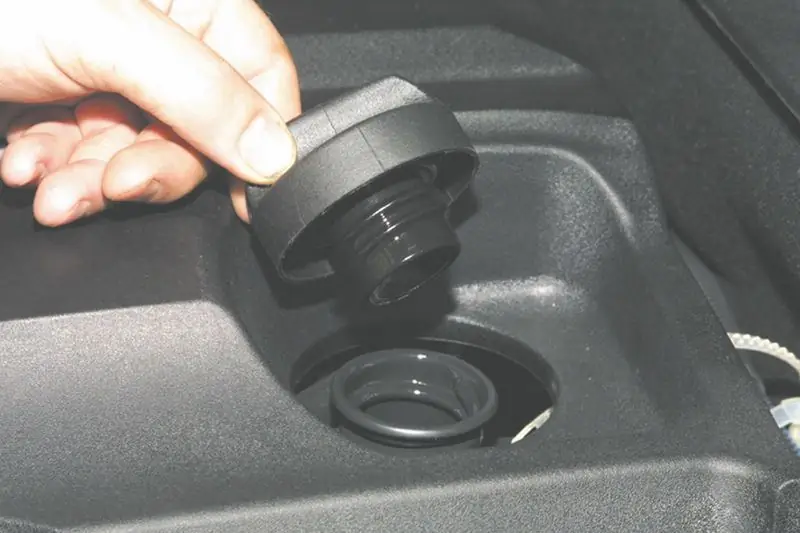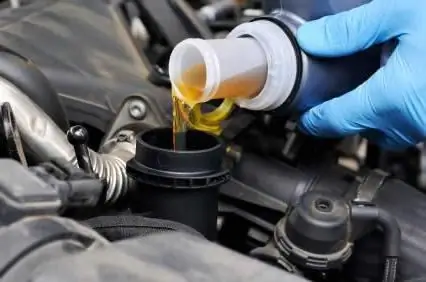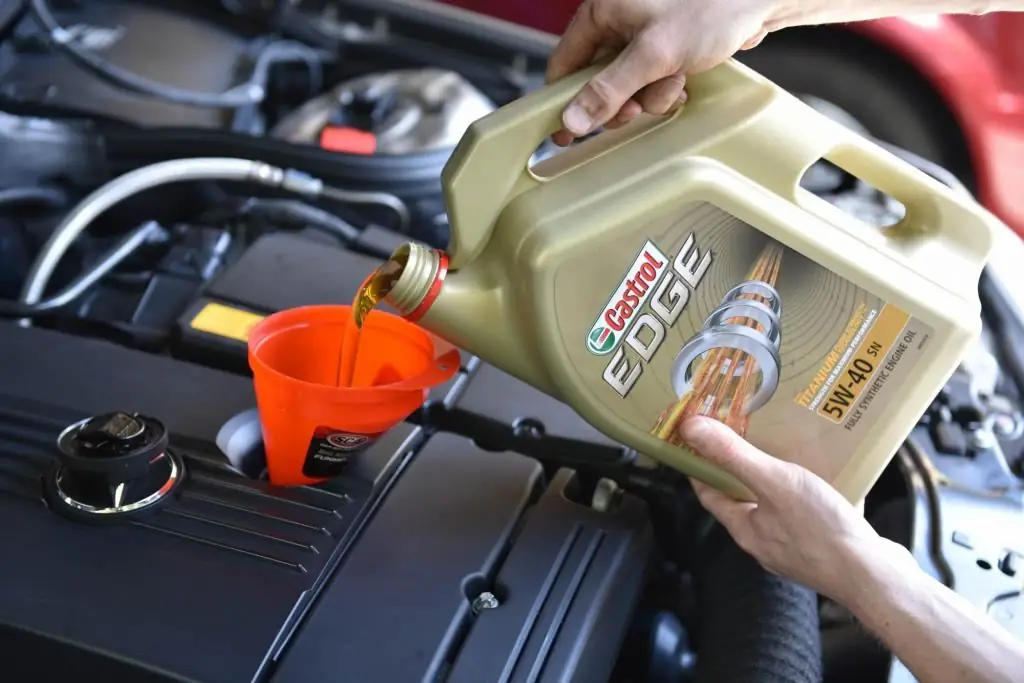2025 Author: Erin Ralphs | [email protected]. Last modified: 2025-01-22 21:14:16
All automotive engine oils are divided into three categories: gasoline, diesel and universal. They are also divided into all-season, winter and summer. But no matter what class they belong to, one thing remains the main characteristic for the oil - viscosity. It is on this parameter that the level of distribution of this liquid on the friction surface of engine parts depends. We can say that the resource of the internal combustion engine of a car largely depends on the viscosity, so today we will devote a separate article to this moment.

Today you will learn what viscosity is and get acquainted with such a concept as deciphering 5w30 engine oil.
What is viscosity?
The main function of this fluid is to prevent friction of parts moving inside the motor “dry”. Also, the oil provides a minimum friction force, while maintaining maximum tightness of the working cylinders.
It is worth noting that the characteristics and lubricating properties of a given fluid can significantlyvary depending on the temperature of the engine itself. By the way, those engine temperature data that are displayed on the car's instrument scale can differ significantly from the level of oil heating. And it is not displayed on the instrument panel in the cabin. Depending on the intensity of the internal combustion engine, this substance can heat up to 140-150 degrees Celsius (and this despite the fact that the operating temperature of the engine will be 90 degrees!). But under such conditions, the viscosity of the liquid may differ significantly from the original.

That's why every car needs a different type of oil recommended by the car manufacturer to ensure the longest possible service life and minimal friction on the cylinder walls.
The viscosity parameter itself is very important for the machine, because the ability of the liquid to remain on the surface of engine parts for a long time depends on it. But this parameter, as we noted earlier, can differ significantly in different temperature ranges. But how then to understand what viscosity the oil should ideally have? Fortunately, the American Association of Automotive Engineers (SAE) has come up with a solution to this problem, which has developed a viscosity classification for automotive oils. In other words, this system gives us the temperature range at which the operation of the internal combustion engine is safe, provided that the manufacturer of the "lubrication" allowed it to be used in this engine with such parameters.
Deciphering the oil label
5W30, 14W-40 - such ciphers are foundabsolutely on every lubricant label. What do they stand for?
In fact, any marking of such a product will include several numbers separated by the letter W and a dash. In our case, the decoding of 5w30 engine oil indicates that this fluid is all-weather - the most popular among motorists. Determining all the detailed characteristics is very simple. Consider this using the example of 5w30 oil.

Deciphering 5W tells us about the low-temperature viscosity of the product, which allows a cold start of the car at a temperature of minus 35 degrees Celsius. This is determined as follows - we subtract 40 from the figure that stands in front of the W value. The resulting number will be the minimum oil temperature at which the internal combustion engine pump can pump it through the system, preventing dry friction of the parts inside.
Minimum engine start level
Similar mathematical manipulations can determine the minimum temperature of the "cranking" of the motor. Using the example of 5w30 oil, the decoding indicates to us that this parameter is minus 30 degrees Celsius. And this is determined very simply: from the obtained value of the cold start temperature of the engine (in our case it is -350) we subtract 35. It becomes obvious that with cooling the oil becomes more and more thick, and the starter harder to crank the engine "cold".
So, we found out what the decoding of 5w30 oil is. Synthetics or "mineral water" - it will depend only on the age of the car. If this is a car older than 5 years, for herit is better to use "mineral water", if younger, then "synthetics".
Pay attention
It should be noted that all the parameters defined above are only averaged for the car. Decoding (including 5w30 oils) gives approximate data. The actual values depend on the characteristics of the engine itself, so when choosing an oil, do not turn a blind eye to the manufacturer's recommendations.
Temperature features
In most cases, modern manufacturers of automotive oils allow their operation at a temperature of no more than minus 20 degrees Celsius. If you live in just such a climate, it is not important for you to choose between 15W-40 and 5W-30 oils. The decoding of both allows operation even in the most severe winter. However, if your starter/battery is badly worn/discharged, a 5W-30 or 0W-30 oil is best. The lower the viscosity, the more likely your starter will turn the engine over and start it "cold".
High temperature viscosity
Another important parameter is indicated after the letter W. These numbers indicate the high temperature viscosity of the oil. In our case, for a 5w30 liquid, this parameter is 30. This value indicates the minimum and maximum viscosity at an operating temperature of 100-150 degrees Celsius.

Unlike the previous cases, nothing needs to be taken away here. Note that the higher this parameter, the higher the viscosity of the oil at high temperatures. But the choice should not be guided byprinciple "the more the better". Again, the automaker himself chooses the optimal parameters, so the viscosity index should not deviate much from the standard norm. You can find all the recommendations in the instruction manual.
When does a car need high viscosity?
Many motorists believe that the higher this parameter, the better the engine will behave. This is partly true.

Why in part? Yes, because oils with high viscosity are recommended to be filled only in sports cars. But this absolutely does not mean that if you pour such a substance into a VAZ, in terms of acceleration dynamics, it will behave like a Lamborghini. Moreover, by purchasing oils with a high viscosity (one that the manufacturer does not recommend), you only aggravate the operation of the engine and increase its load. As a result, the car loses its power, and if you refill the liquid, it is possible that soon your engine will only be subject to major repairs.
How often should the oil be changed?
Finally, we note the most optimal replacement interval. It is generally accepted that oil exhausts its resource after 10 thousand kilometers. It is with this interval of time that it is best to change the fluid in the car. The owners of cars with LPG are more fortunate: thanks to the more environmentally friendly combustion of gas (it doesn’t matter if it’s propane or methane), the oil practically does not clog and retains its transparency even at 20 thousand mileage. You should also regularly check the level of its residue inengine.

This should be done at least once every 2 weeks. Otherwise, you will not know if it remains in the engine at all, and a dry start can lead to serious consequences, up to a major overhaul. So take care of your car and choose the right oils, following the recommendations of the manufacturers.
So, we found out what the decoding of SAE 5w30 is, and found out all the nuances of viscosity, as well as the optimal replacement interval for this fluid.
Recommended:
Changing the oil in a Mercedes. Types of oil, why it needs to be changed and the main task of engine oil

A car is a modern vehicle that needs to be monitored every day. A Mercedes car is no exception. Such a machine should always be in order. Changing the oil in a Mercedes is an important procedure for a vehicle. In this article we will talk about how important it is to carry out this procedure, what types and types of oil are
Changing the oil in the Chevrolet Niva engine: the choice of oil, the frequency and timing of oil changes, tips from car owners

The car's powertrain needs regular maintenance. The engine is the heart of any car, and its service life depends on how carefully the driver treats it. In this article we will talk about how to change the oil in a Chevrolet Niva engine. Despite the fact that every motorist can do this, there are some nuances that you must first familiarize yourself with
Engine oil change intervals. Diesel engine oil change interval

Frequency of oil change in engines of various car brands. How to choose engine oil? Detailed instructions for changing the oil. Tips from auto mechanics
Engine error: decoding, reasons. How to reset an engine error?

Probably, every owner of a car with an injection engine has encountered various errors in the operation of this unit. Such a trouble is reported by the corresponding sign on the instrument panel - "engine error". Many will immediately go to the service station for diagnostics, while others will go with this problem. But the third group of people will definitely be interested in the reasons and decoding of the codes
Why does engine oil turn black quickly? Selection of oil for the car. Terms of oil change in the car engine

Why does engine oil turn black quickly? This question worries many motorists. There are many answers to it. Let's consider them in our article in more detail. We will also pay special attention to the most common types of additives used to improve oil performance

